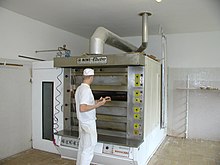Dough piece

Dough piece refers to a finished, shaped piece of raw dough . It can be fresh as well as in a chilled ( fermentation-interrupted ) or frozen state.
Dough pieces enable baked goods sales stands in supermarkets, train stations or petrol stations to offer freshly baked pastries and bread without the need for a bakery . The baking of dough pieces can also be done by unskilled assistants with stationary ovens ("in-store baking"). The smell of freshly baked goods is an important incentive to buy
The increasing spread of such baking stations around the year 2000 led to the bypassing of the night and Sunday baking ban . After real bakeries complained about increasing losses in sales and competitive disadvantages that arose from selling bread rolls at gas stations, the labor and trade regulations in this area were relaxed. This is why bakeries are now allowed to bake and sell pastries early on Sundays.
These sales channels required new technologies in the bakery: fermentation delay and fermentation interruption .
Fermentation delay
By cooling to +5 to –5 ° C, the dough pieces can be stored for up to 24 hours. The yeast cells largely cease their activity and the enzymes work very slowly. So bakers can offer fresh baked goods (pretzels, croissants, Danish pastries) several times a day.
Fermentation interruption
Dough pieces at –18 ° C can be stored for up to 72 hours. B. a weekend or a public holiday can be bridged.
So that the dough pieces are not damaged by the cold, you add some fat and / or special baking agents for proofing retarders or proofing interrupters. In this way, dough pieces can be baked out as required after a short time.
Frozen dough
A frozen dough piece is a raw, pre-cooked and pre-formed dough that has been shock-frozen under special conditions. The freshness and taste should be optimally preserved. Shock freezing brings the dough to a core temperature of –7 ° C. This not only makes it durable, but also transportable. One speaks here of a targeted " fermentation interruption ", since the yeast cells are stopped in their activity. Only when thawing, in the proofer , do the yeast cells start their work again and let the dough rise further. They achieve their full effect when baking and the dough rises ( oven shoots ). In Austria, Anton Haubenberger IV ( Haubis ) was the first to develop frozen dough . With this innovation, he was able to significantly expand his sales channels.
Shock freezing vs. Freezing
In order to properly shock-freeze a piece of dough, you not only need sufficiently cold temperatures, but also wind, which ensures that the moisture from the dough is blown away. Otherwise, large ice crystals would form and destroy the yeast cells. This dough would no longer rise properly when baked.
In a shock freezer, the dough pieces must therefore be shock frozen from 35 ° C (and a wind speed of 120 km / h) to a core temperature of −7 ° C within 30–50 minutes. Only small ice crystals form, which do not damage the yeast cells. The cell walls remain intact.
In normal household freezing, large ice crystals form that destroy the cell walls - the dough no longer rises after thawing.
Storage in the freezer
When the core of the frozen food has reached -7 ° C, the temperature is further reduced to -18 ° C. At this consistently low temperature, the dough pieces can be stored for the rest of the freezing period.
Web links
Individual evidence
- ↑ In- store baking , on miwe.de, March 2020
- ↑ a b c Josef Loderbauer: The baker's book in learning fields . ISBN 978-3-582-40205-9 , pp. 340 .
- ↑ a b c product design. Accessed March 31, 2020 .
- ↑ Haubis GenussKultur with family tradition. Accessed March 31, 2020 .

